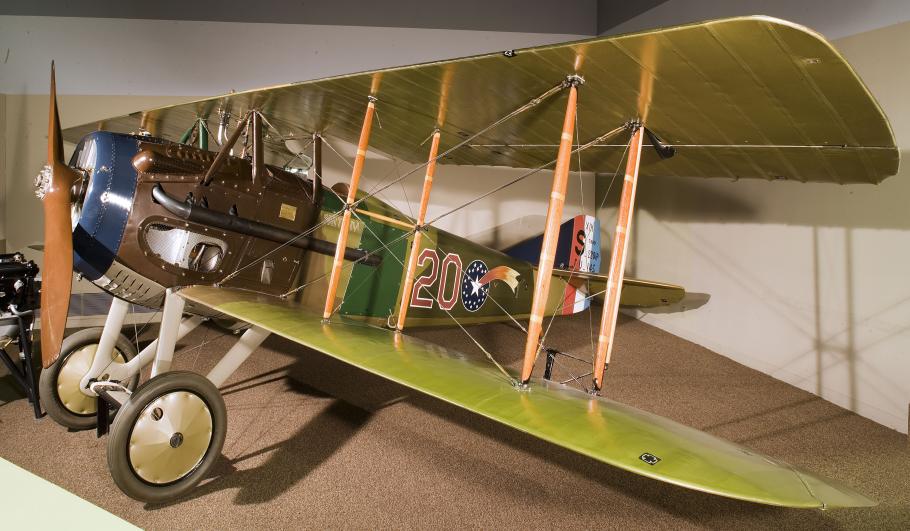One-hundred years ago, World War I was raging in Europe. In the end, over 17 million lives were lost, among them seven million civilians. More than 40 countries were involved in the most widespread war the world had ever seen, a war that was fought in Europe, the Near East, Africa, East Asia, and on the world’s oceans. Starting just 11 years after the invention of powered flight, the Great War was the first major conflict in which pilots and airplanes were involved, experiencing their baptism by fire. At the beginning of the war, military applications of the new technology were barely known. At the end of the war, there was a vast array of fighter planes, reconnaissance planes, and bombers. Dogfighting tactics and bombing strategies had been developed, with weapons and armaments now essential elements in military aircraft. World War I transformed fragile flying contraptions, made of wood and fabric, into reliable killing tools, performing at parameters the world could not have imagined just a few years earlier. The image of pilots took on a similar transformation: The intrepid, adventurous birdmen of pre-war years became romantically adored “knights of the air” like Manfred von Richthofen (Germany), Albert Ball (Great Britain), George Guynemer (France), and Eddie Rickenbacker (USA). The lives and kills of these pilot-aces became material for legendary folklore and national propaganda. I recently returned from Germany where I met with the creators of an amazing online project that allows us to experience this metamorphosis of aviation through the eyes of three ordinary people involved: British pilot Bernard Rice, French pilot Jean Chaput, and German pilot Peter Falkenstein. Three Pilots - One War is a shared project of the Royal Air Force Museum in London, the Musée de l’Air et de l’Espace in Paris Airport/Le Bourget, and the Military History Museum of the German Armed Forces/Air Force in Berlin-Gatow. The website has published the letters of these three pilots exactly 100 years after they were first written. Transcribed and translated in all three languages (English, French, and German), the notes allow a glimpse into the everyday life of three young men who were thrown into the upheaval of war. We read about the banalities and dangers of war life, about them showing courage in battle and missing their loved ones. We experience the pride all three of them feel in being a wartime pilot. Enhanced by other personal documents and information, intimate images of the young men begin to emerge before our eyes as we follow their story. The project will continue until the end of 2018, a worthy endeavor to remember the birth of military aviation, and the lives of three young pilots in the Great War—a war that one of them would not survive.
From left: British pilot Bernard Rice, French pilot Jean Chaput, and German pilot Peter Falkenstein.
The National Air and Space Museum holds a large collection of objects related to World War I aviation that complement the stories told in Three Pilots – One War. At the Museum in Washington, DC, our exhibition Legend, Memory, and the Great War in the Air reexamines the romantic notions about early aerial warfare and contrasts it with reality. The exhibition also holds a number of rare aircraft: from Germany the Pfalz D.XII, Albatros D.Va, and Fokker D.VII fighters; from Great Britain the rare Sopwith 7F.1 Snipe fighter; and from France the Voisin Type 8 bomber, the oldest surviving aircraft specifically designed as a bomber. There’s also a SPAD XIII fighter, a type which had been flown by many of the famous Allied pilots of World War I. The SPAD XIII was purchased from its French manufacturer and thus is operationally an American airplane, exclusively flown by an American pilot in an American unit.
Visitors to the Steven F. Udvar-Hazy Center in Chantilly, Virginia will find World War I aircraft there as well. Among them are a Caudron G.4, one of the very few remaining multi-engine aircraft of this early period; a Nieuport 28C.1, the first fighter aircraft to serve with an American fighter unit under American command in the war; and a Spad XVI, which was piloted by General William “Billy” Mitchell during many observation flights during the last months of the war. Udvar-Hazy holds a German aircraft of World War I, the Halberstadt CL.IV, one of the best ground attack aircraft of the war.
Studying these aircraft and exploring the personal stories of the pilots who flew them illuminates the rapid functional and technological development that military aircraft experienced between 1914 and 1918.

